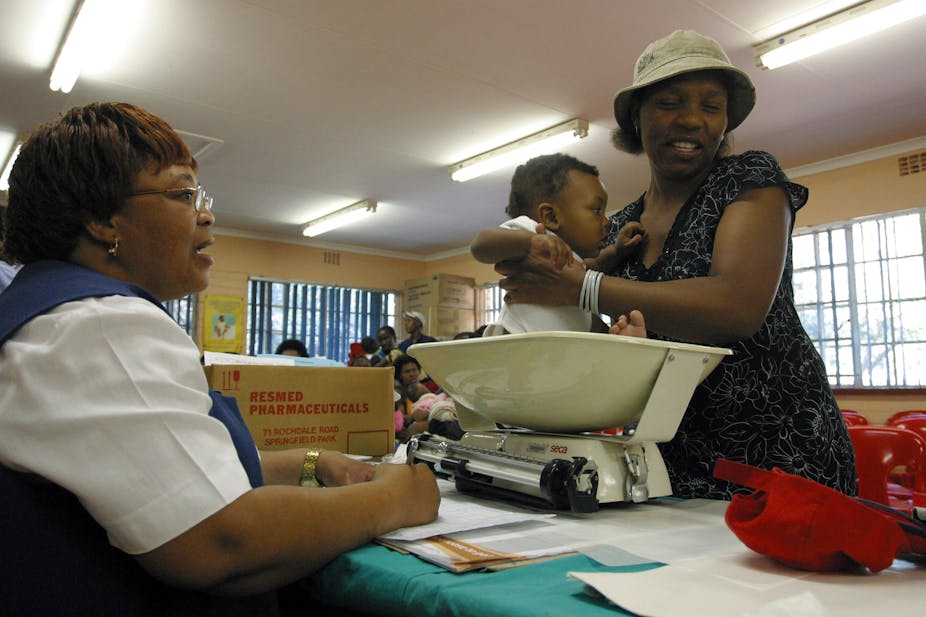For the second time the world is celebrating Universal Health Coverage Day. It comes as the South African government releases its universal health coverage policy to ensure equitable, accessible and affordable healthcare: the National Health Insurance White Paper.
Although the goal of universal health coverage has been a feature of the country for the past two and a half decades, implementation has not been effective.
On taking office, President Nelson Mandela launched his flagship project: free health services for pregnant women and children aged under 6. This was followed by free primary healthcare services. Mandela recognised access to healthcare as an essential human right. But he also realised it was an important contribution to the nation-building project, along with other elements of the African National Congress’ Reconstruction and Development Programme.
Yet, in 2015, the picture is far from perfect. About 8 million South Africans have expensive private healthcare while 42 million people rely on an under-resourced public sector. Inadequate access to healthcare perpetuates inequalities.
In addition, South Africa has a “missing middle”. These are people who are insufficiently poor to be exempted from paying user fees for public hospital services but often too poor to afford them. Many eligible for “free” healthcare face insurmountable indirect costs, especially for transport At the same time, for many who belong to medical schemes, monthly contributions and associated out-of-pocket payments consume an unsustainable proportion of their incomes.
How can this be, given the early aspirations of the first democratic government?
A lost decade
The first decade of the post-apartheid era saw a surprising decline in per capita government expenditure on health, after taking inflation into account. This happened despite increasing per capita Gross Domestic Product. The share of the government budget allocated to health also declined and stagnated at around 11.7% for much of this decade. It has never returned to its 1996 high of 14.1%.
This was linked to the implementation of a macroeconomic policy called the Growth, Employment and Redistribution strategy (GEAR) which was launched in 1996. The strategy reined in public expenditure and resulted in a squeeze on spending for health and education.
At the same time the Department of Health was struggling to remedy severe backlogs in healthcare infrastructure and human resource production inherited from the apartheid era. The HIV/AIDS epidemic was also escalating into the biggest in the world.
Solving the problem
If South Africa is to achieve equitable access to the full range of health services - not only primary healthcare services but also to hospitals - the fiscal policy limit on government revenue as a percentage of GDP needs to be lifted.
The limit of 25%, applied since GEAR was introduced, is well below the average in other middle-income countries. Latin America sits at over 32% link while Central and Eastern Europe sits at 37%. The average for countries in the Organisation for Economic Cooperation and Development (OECD) in 2013 was 34%. Increasing this limit is critical, given massive income inequality in South Africa.
It will be important to focus on progressive revenue sources, including taxing the wealthiest more effectively, as well as multinational corporations. This would be in line with the global agreement reached for funding the sustainable development goals.
But new government revenue will not easily flow to the health sector. National and provincial health leaders have generally battled to make the case for health in national and provincial decision-making bodies. This has been a function, at some points, of weak health leaders combined with insufficient technical and analytical capacity to support bids, especially in costing programmes.
Successive ministers of finance have also at times resisted requests for increased funding from the Department of Health, especially when they distrusted the public health sector’s ability to deliver.
These are some of the political and administrative challenges that characterise the struggle policy-makers and health advocates face on a daily basis to protect spending on healthcare. These challenges will intensify with the struggle to implement National Health Insurance.
To preserve the impetus towards universal health coverage, the Minister of Health and others need to engage with debates within Cabinet and Treasury on appropriate macroeconomic and fiscal policy choices. The Department of Health will strengthen these arguments, and win the trust of colleagues from Cabinet and Treasury, if it is able to demonstrate achievements in service delivery and combat corruption.
*This article is based on an article that appeared in the South African Medical Journal in December 2015.

